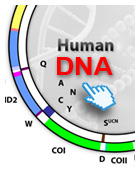MITOCHONDRIA
What are mitochondria?
Mitochondria are double-membrane organelles that
populate by the hundreds or thousands the cytoplasm of all cells in the human
body.
Their main function is to produce energy through a
metabolic process called oxidative phosphorylation (OXPHOS). More than 90% of
the energy utilized by our organism is produced in the mitochondria. When a
failure in energy supply occurs, due to defective mitochondrial OXPHOS, the
life of the cell, and indeed that of our entire organism, is seriously at risk.
Tissues and organs with the highest energy demand, including the brain,
skeletal muscles, and the heart, are usually the most affected ones. Energy
supplied by mitochondria is indeed fundamental for every cell and thus it is
possible a multisystem involvement (with deafness, optic atrophy, diabetes,
hepatic and renal dysfunction, gastrointestinal problems…). The OXPHOS process
takes place in the internal membrane of mitochondria, through a sequential
series of reactions of reduction and oxidation, which form the so called “cellular
respiration” and are carried out by the four enzymatic complexes of the
mitochondrial respiratory chain (Complex I; Complex II; Complex III; Complex IV
or cytochrome-c-oxidase). In this reaction, electrons liberated by the
controlled degradation of nutrients are ultimately combined with molecular
oxygen to produce water. The energy released during these reactions is used by
Complex V, or ATP-synthetase, to produce the compound adenosintriphosphate
(ATP), the fundamental “fuel” for cellular metabolism. From a genetic point of
view, the respiratory chain has unique features since it is composed of
proteins encoded by two different genetic systems: the nuclear genome, which is
inherited from both parents, and the mitochondrial genome, which is inherited
exclusively from the mother. As a result of this dual genetic inheritance,
OXPHOS defects can be caused by mutations in either mitochondrial or nuclear
genes.
The mitochondrial genome
Mitochondria have their own DNA, called mitochondrial
DNA (mtDNA). mtDNA is an extremely small, circular mini-chromosome, present in
several copies in each organelle, and containing only 37 genes. 13 genes encode
as many protein subunits of the OXPHOS complexes, whilst 24 genes encode RNA
molecules including 2 ribosomal RNA (rRNAs), and 22 transfer RNAs (tRNAs) that
are indispensable for the in situ synthesis of the mtDNA-encoded protein
subunits.
After fertilization, mitochondria present in the new individual (zygote) originate only from the egg cell. In principle, a mother carrying an mtDNA mutation will transmit it to all her children, but only her daughters will be able to transmit this mutation to the subsequent generation. This pattern of transmission is called maternal inheritance.
In contrast to the double nuclear gene copies, that are called paternal and maternal alleles, present in human nuclei, there are hundreds of mtDNA molecules contained in each cell. In a normal individual, all the mtDNA molecules are identical, a condition called homoplasmy. Deleterious mtDNA mutations generally strike only a fraction of the mitochondrial genomes of an individual, leading to the coexistence in cells and tissues of two mtDNA populations, one normal and one mutated. This condition is called heteroplasmy. However, it is only when the mutated genomes reach a critical threshold over the normal genomes, that an effective reduction of OXPHOS activity occurs and thus the clinical manifestations of disease.





